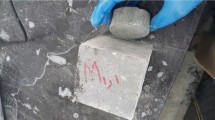Abstract
Strength monitoring is a crucial aspect in determining the durability and serviceability of concrete based structures. Strength monitoring can be done using two main approaches which are broadly termed as destructive testing and non-destructive testing. This study focusses on the applicability of non-destructive techniques (NDT) for concrete testing such as acoustic emission technique (AET) and ultrasonic guided wave (UGW) method in order to monitor early age setting properties of concrete which is modified by flyash addition. Experimental investigation was carried out on concrete mixes containing varying amounts of flyash which went up from 0% till 30%. Early setting and hardening of 150 mm*150 mm concrete cube specimens embedded with mild steel rods were monitored using AET and UGW techniques. The aim of the current study was to monitor all the aspects of the setting as well as hardening process of concrete containing flyash using NDT techniques. The results so obtained were then compared to destructive testing results. It was found that AE and UGW were successful in identifying the various stages of concrete setting and hardening. Due to slower reaction of flyash, it was reported that the fluid zone extended over a larger period of about 26–40 h as against that for the control concrete which was found to be 24 h. Further Scanning Electron Microscopy was used to validate the results obtained by NDT testing as well as by compressive strength testing.
Access this chapter
Tax calculation will be finalised at checkout
Purchases are for personal use only
Similar content being viewed by others
References
Haneef TK, Kumari K, Mukhopadhyay CK, Rao BP, Jayakumar T (2013) Influence of fly ash and curing on cracking behavior of concrete by acoustic emission technique. Constr Build Mater 44:342–350
IS 10262 (2009) Concrete mix proportioning-guidelines, Bur. Indian Stand. Delhi
IS: 8112 (2013) Specification for 43 grade ordinary Portland cement by Bureau of Indian Standards
Lee HK, Lee KM, Kim YH, Yim H, Bae DB (2004) Ultrasonic in-situ monitoring of setting process of high-performance concrete. Cem Concr Res 34(4):631–640
Nicolas R, Nele DB (2009) Monitoring the setting of concrete by measuring the change in ultrasonic p-wave energy, NDTCE, Nantes, France
Robeyst N, Gruyaert E, De Belie N (2007) Ultrasonic monitoring of setting and hardening behaviour of concrete and mortar with blast furnace slag cement. In: 12th International congress on the Chemistry of Cement (ICCC 2007)
Sharma S, Mukherjee A (2010) Longitudinal guided waves for monitoring chloride corrosion in reinforcing bars in concrete. Struct Health Monit 6(9)
Shahidan S (2014) Damage classification in reinforced concrete beam by 45:78–86
Sharma S, Mukherjee A (2014) Ultrasonic guided waves for monitoring the setting process of concretes with varying workabilities. Constr Build Mater 72:358–366
Sharma S, Mukherjee A (2015) Monitoring freshly poured concrete using ultrasonic waves guided through reinforcing bars. Cement Concr Compos 55:337–347
Author information
Authors and Affiliations
Corresponding author
Editor information
Editors and Affiliations
Rights and permissions
Copyright information
© 2024 The Author(s), under exclusive license to Springer Nature Singapore Pte Ltd.
About this paper
Cite this paper
Kumar, P., Sidhu, J. (2024). Early Setting and Hardening of Concrete Containing Flyash Using Non-destructive Techniques. In: Goel, M.D., Vyavahare, A.Y., Khatri, A.P. (eds) Recent Developments in Structural Engineering, Volume 4. SEC 2023. Lecture Notes in Civil Engineering, vol 549. Springer, Singapore. https://doi.org/10.1007/978-981-97-6603-1_45
Download citation
DOI: https://doi.org/10.1007/978-981-97-6603-1_45
Published:
Publisher Name: Springer, Singapore
Print ISBN: 978-981-97-6602-4
Online ISBN: 978-981-97-6603-1
eBook Packages: EngineeringEngineering (R0)




